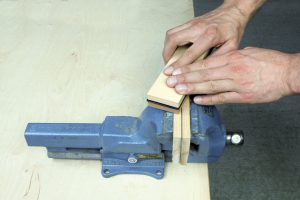Scraper blades
Trueing
Scrapers are usually stamped, which means the edges must be worked with a file to obtain an evenly square edge, using one of the following methods: There are file holders with a 90° fence which allow even less-experienced users to control the file securely. You can make similar holders of wood yourself. But the simplest and cheapest method is clamping the scraper between two pieces of wood.
- Find two pieces of wood (90° edge at the top) or bits of board with hich you can fix the scraper in a vice (alternatively, you can clamp the scraper between these two supports on a large beam with a clamp)
- Let the scraper project by about 1 mm
- Work on the projecting scraper with the file until it is almost flush with the supports
- Make longitudinal or slightly diagonal strokes until the file almost touches the supports
- The wooden supports now provide a large support area that makes it easy to guide the file or stone at a 90° angle
Finishing the blade
Finishing the blade
- Hold the combination stone in your hand and guide it along the support area you have just created (scraper-support combination in the vice)
- A few strokes with the 1000 grit side and then with the 6000 grit side should be enough
Raising the burr
- Slide the scraper further up between the supports
- How far the scraper should project depends on the required angle (normally 10°-15°)
- To estimate the angle, place the burnisher not only onto the scraper edge but also onto the edge of the support; viewed in profile, you can estimate the angle
- Drawing the burnisher along the edge of the support creates a consistent angle
- Pull the burnisher over the entire edge in a single stroke, applying sufficient pressure (a slightly diagonal stroke enables accurate application, even at the end of the scraper)
Checking the burr
You can now feel the raised burr with your fingertips. Depending on how hard the scraper and the pressure applied, you may need to burnish the edge again. However, you should not burnish more than three times, as each process may ruin the even burr. The deeper the angle used in burnishing, the larger and more »aggressive« the burr. How large a burr is required depends on the intended use: Removing varnishes and coats requires a large burr. Surface finishing requires a small burr.
Reburnishing the burr
You can also right the burr with the burnisher and raise it anew, but this process does not usually produce consistent results. We therefore recommend completely removing the burr on worn scrapers with a file before raising a new one.


